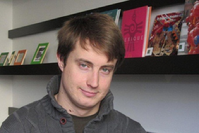Coherent anti-Stokes Raman scattering microscopy for pharmaceutics – A shift in the right direction
Promotion date: 4th of July 2014.
Promotor: Prof.dr. Jennifer Herek
Assistant Promotor: Dr.ir. Herman Offerhaus and Dr. Clare Strachan
| Coherent anti-Stokes Raman scattering (CARS) microscopy is demonstrated as a tool in pharmaceutical solid state developments, over a wide range of samples. CARS is a nonlinear optical imaging technique using inelastic scattering of light. Three imaging techniques are available here: rapid imaging at a single Raman vibrational frequency, z-stacked imaging at a single Raman vibrational frequency, and hyperspectral imaging over a range of Raman vibrational frequencies. Singe plane CARS imaging has the main strength of being rapid, providing up to video rate images, allowing visualization of chemical changes. Hyperspectral CARS imaging can record images at different frequencies, which are then processed and projected in a single image. Here, the sample must remain stationary. Z-stacked imaging provides the capability of three-dimensional imaging. In pharmaceutical use, rough surfaces such as powders and granule samples can be imaged. Two main areas of future development of narrowband CARS that would be beneficial for pharmaceutical analysis are: Raman fingerprint imaging and quantitative image analysis. Using complex mathematics, it could be possible to calculate chemical concentrations in these CARS images as well.
|
Was your research application driven?
My thesis project was aimed at the interface of physics and pharmaceutics. I explored CARS microscopy to be used as a tool in drug development, especially in testing tablets and powders. By using CARS it is possible to investigate one chemical only, and look for example at its distribution. This can be done without additional labeling or fluorescent techniques, or using special proteins as an intermediate. A nice example would be the projected z-stack images showing the distribution of budesonide on the surface of lactose carrier particles.
Can you recall some special moments during your PhD project?
Being able to combine and compare CARS en SEM techniques was a special moment, as quite a lot of practical difficulties had to be overcome. Especially moving the sample from the one apparatus to the other was a challenge, as some very loose micrometer scaled subparts were involved.
For this subsection of my PhD research, I first went to Groningen to perform SEM measurements. Later on I was able to perform correlative SEM measurements and CARS measurements, here at the Mesa+ Nanolab.
Did you have some good articles published?
Some of these were in pharmaceutical journals: European journal of pharmaceutics and bio-pharmaceutics, International Journal of Pharmaceutics. Also articles in Journal of Raman Spectroscopy (on using CARS as a tool for studying adhesive mixtures for inhalation) and Reviews in Analytical Chemistry were published. Another article is submitted.
A very special experience was working on a video presentation for the Journal of Visualized Experiments (JOVE). This is a new concept of making scientific research accessible and visible for a broader audience, as well as for the scientific community. For some experiments this could be a valuable addition to traditional ways of publishing, I guess. However, double effort is required as one has to write an authorized script and then perform as an experimenter while followed by a camera filming all the script stages. This was quite nerve-wracking, I can tell.
In what way did you develop as a scientist and researcher?
I am a lot more patient when compared to four years ago, I guess. Now I am used to the fact that experiments will never be fulfilled perfectly. PhD work is a process of iterative learning, trying and revising time and time again. By doing so, gradual progress is made.
What are your future plans?
I am already working in a company here in Twente, in Almelo, called PANalytical. This is a renowned, high-tech company. In my job now I have a product management role which I chose deliberately, as a nice break from scientific research.
In this job I attend a lot of meetings. However, some overlap still exists with my PhD work as collaboration with universities and knowledge institutes is of prime importance for this company. The machinery and analytical equipment is of strategic importance. As an intermediate, my knowledge can be of use here.
What, in your opinion, is important for Mesa+ to stay successful in future?
The expertise of the Applied Nanophotonics group fits the future strategy of Mesa+ very well. It is a good thing this is taken as a strategic research orientation.
Also I would like to stress the importance for all Mesa+ researchers to make sure Mesa+ is mentioned as the institute one works for, on all publications and presentations. Sometimes only the University of Twente is mentioned, which is a bit of a missed chance.

